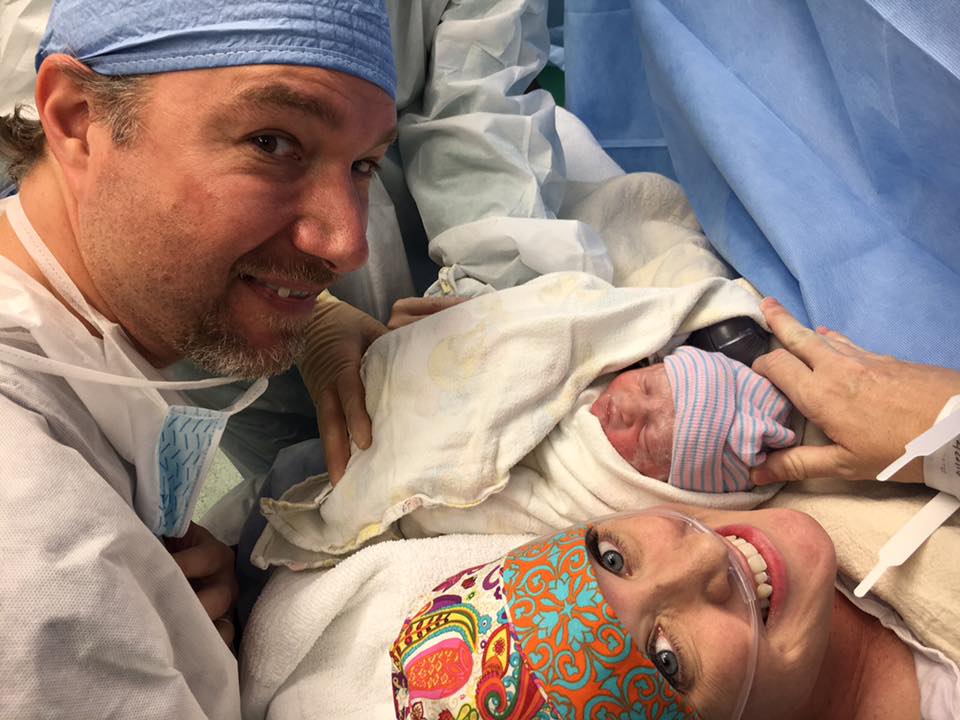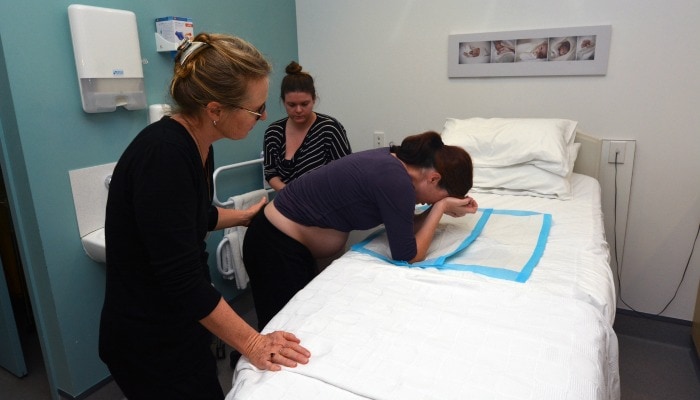Ladies, communicating your birth preferences with your healthcare team is one of the most important things to learn during pregnancy. Turns out, women are more satisfied with their birth experiences when they remain an active participant in the decision making process no matter the outcome. Therefore, it’s imperative that all new moms understand and execute the following tips for communicating their preferences to their birth team.

On This Page
8 minute read
⬇Healthcare Team Wants What’s Best
⬇Make a Birth Plan – One Page, One Sided
⬇Use Positive Language
⬇Use Simple Formatting
⬇Include a Cesarean Birth Plan and Other Contingency Plans
⬇Learn the BRAIN Acronym
⬇Bring a Birth Plan to Prenatal Appointments
⬇Discuss One Preference At a Time – Notice Responses
⬇Pay Attention to “Let You” Phrasing
⬇Consider Hiring a Different Care Provider
⬇Educate Birth Team On Birth Plan
⬇Bring a Birth Plan to Labor & Delivery
⬇Ask For a Different Nurse
⬇Bring a Doula to L&D
Healthcare Team Genuinely Wants What’s Best
Before exploring tips for communicating your birth preferences with your healthcare team, I think it’s helpful to remind ourselves of their positive intentions. There are exceptions, but most care providers genuinely want what’s best for you and your baby. What’s best may be disagreed upon, but ultimately they are doing the best they can in their world on that day with what they know. Just like you!

Make a Birth Plan – One Page, One Sided
In order to communicate birth preferences to care providers, parents need to figure out what’s most important to them. To do this, I highly recommend creating a birth plan. One of the major benefits of making a birth plan is to help parents understand their options and preferences for labor, delivery, and postpartum. The decision making process is better when everybody knows and understands their options. If new parents are unsure of their options, I highly recommend taking a quality childbirth class and consulting with a doula.
“When you know better, do better.” – Maya Angelou
When writing a birth plan, feel free to use one of the thousands of birth plan templates available on the internets. Whatever you choose, consider the following tips to help communicate clearly with your healthcare team.

Use Positive Language
Whatever your birth preferences, make sure to use positive language like “I would like delayed cord clamping immediately after birth” instead of “don’t cut the umbilical cord before it stops pulsing”. Positive language is received better on a written birth plan.
Use Simple Formatting
Labor and delivery is a fast paced environment and birth plans are initially scanned and not read in depth. Therefore, format birth plans to be easily read and keep it only to one page. Bold keywords so that a nurse can quickly put the pieces together to understand your intentions for birth.
“I would like delayed cord clamping immediately after birth.”
Include a Cesarean Birth Plan and Other Contingency Plans
First time moms not planning a cesarean tend to not to prepare for one either. Parents don’t think about making a contingency plan because they don’t want it to happen to them. Some even think that planning for a cesarean increases their chances of having one. This is simply not true! However, considering the high cesarean rates it makes a lot of sense to prepare for a cesarean even if that’s not the plan. Don’t get caught off guard!
If for whatever reason a cesarean birth became your next best thing, your future self will thank you for having birth preferences to communicate in this unexpected situation. Your birth preferences matter even when plans change!

Learn the BRAIN Acronym
One of the best tools for getting informed consent to make educated decisions is the brain acronym tool. Learn how to use this tool by memorizing the acronym, but then roleplay it with a friend or family member. Do this a few times to hone this skill, because you’ll need it to communicate your birth preferences with your healthcare team. Don’t skip over this one! It’s so important.

Bring a Birth Plan to Prenatal Appointments
Now that parents have educated themselves, chosen birth preferences, and created a written plan, it’s time to bring birth plans to prenatal appointments. It’s helpful to bring birth plans to prenatal appointments because it facilitates discussion between parents and their care providers. Not only are wishes and preferences addressed, but it’s also an opportunity to see the MO of doctors, nurses, and midwives. This is very helpful information!

Discuss One Preference At a Time – Notice Responses
Over the next few weeks at prenatal appointments, plan to bring up one issue or preference at a time. Prenatal appointments are sometimes rushed, so it’s important to have reasonable expectations for addressing your concerns. I recommend starting with your biggest concern, and then moving forward from there.
Use the neutral phrase “I am interested in ______. What are your thoughts about that?” to get the conversation started.
Pay Attention to “Let You” Phrasing
A phrase to look out for when discussing birth preferences with your healthcare team is the phrase “let you”. Does your OB tell you what they’ll let you do? Do you ask if they’ll let you do something? This language subtly shifts autonomy away from mothers and gives it to their care providers. Instead, turn the tables and use that phrasing on them and notice how that unfolds. This is a good predictor of the type of care you’ll receive during labor and delivery.
Consider Hiring a Different Care Provider
Of course, when communicating your birth preferences with your healthcare team it sometimes becomes apparent that they’re not a good fit. It’s not too late to find a new doctor or midwife! I had a friend switch care providers in labor so she could have the options she was requesting. You have options! To think about this more in depth, make sure to check out warning signs you need to fire your OB.
Educate Birth Team On Birth Plan
Make sure to discuss birth plans with the birth team and those invited to the big day. This is helpful so birth partners know what to expect and how to help, but also to assess their level of support. (Here’s lookin’ at you, grandmothers-to-be! 😉 ) Some family members are amazing for support during birth, and some should probably have a different job. Figure this out ahead of time for a smoother birth experience.

Bring a Birth Plan to Labor & Delivery
Upon admission to L&D at my local hospital, women are respectfully asked their intentions for pain management in labor. They’re also asked to see a birth plan if one exists. This is an excellent use of a birth plan – to communicate your birth preferences to the nurses straight out of the gate. It’s also helpful at shift change to bring nurse #2 up to speed. Birth plans are a quick and efficient way to understand the plan with minimal communication, since parents are busily coping through contractions.

Ask For a Different Nurse
Many parents wonder how to handle the situation where their nurse is not a good fit. If parents and their nurse are butting heads and not seeing eye-to-eye, it may be helpful to request a new nurse. To do this, visit the charge nurse at the nurse’s station and have a chat. This is an additional opportunity to communicate birth preferences. Who knows, maybe simply speaking to the charge nurse can help smooth things over.

Bring a Doula to L&D
One of the best and most reliable methods of communicating your birth preferences on the big day is by bringing a doula. Doulas are like a walking birth plan. Birth doulas are great at helping carry out the wishes of mothers and facilitating communication between their clients and care providers. As a bonus, doulas decrease the chance of cesarean by 50%, which is awesome. Medicaid even reimburses for doulas! New doulas are great too!

Want More?
If this was helpful, below are more tips and advice for navigating hospital birth. See what appeals to you and read more!
What to Pack in a Hospital Bag for Birth
When to Take a Hospital Tour
How to Get the Dirty Details on Your OBGYN
Tips for Dads in the Delivery Room
411 Contraction Rule
How Far Apart Should Contractions Be Before Going to the Hospital?
The Best Advice for a Natural Hospital Birth
10 Proven Tips for a Successful VBAC
IV Pain Meds in Labor – An Epidural Alternative
Birth Documentaries for Parents to Watch
You Need to Know – Most Get Pitocin After Birth
3 Mistakes to Avoid Immediately After Birth
